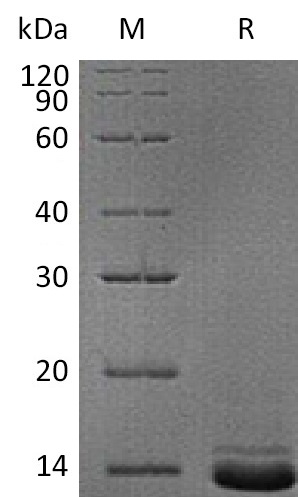Shopping Cart
- Remove All
 Your shopping cart is currently empty
Your shopping cart is currently empty

Pro-Neuropeptide Y (NPY) is a member of the NPY family. NPY is a secreted protein and is one of the most abundant peptides in the nervous system. It also can be found in some chromaffin cells of the adrenal medulla. NPY can be cleaved into Neuropeptide Y and C-flanking peptide of NPY chain, which regulates energy usage, and it is involved in learning, memory processing, and epilepsy. NPY is implicated in the control of feeding and in secretion of gonadotrophin-release hormone. In addition, NPY increases the proportion of energy stored as fat and blocks nociceptive signals to the brain.

| Pack Size | Price | Availability | Quantity |
|---|---|---|---|
| 10 μg | $129 | 7-10 days | |
| 50 μg | $390 | 7-10 days | |
| 500 μg | $1,900 | 7-10 days | |
| 1 mg | $2,730 | 7-10 days |
| Biological Activity | Activity has not been tested. It is theoretically active, but we cannot guarantee it. If you require protein activity, we recommend choosing the eukaryotic expression version first. |
| Description | Pro-Neuropeptide Y (NPY) is a member of the NPY family. NPY is a secreted protein and is one of the most abundant peptides in the nervous system. It also can be found in some chromaffin cells of the adrenal medulla. NPY can be cleaved into Neuropeptide Y and C-flanking peptide of NPY chain, which regulates energy usage, and it is involved in learning, memory processing, and epilepsy. NPY is implicated in the control of feeding and in secretion of gonadotrophin-release hormone. In addition, NPY increases the proportion of energy stored as fat and blocks nociceptive signals to the brain. |
| Species | Human |
| Expression System | HEK293 Cells |
| Tag | C-6xHis |
| Accession Number | P01303 |
| Synonyms | Pro-Neuropeptide Y,NPY,Neuropeptide Y,Neuropeptide Tyrosine,CPON,C-Flanking Peptide of NPY |
| Amino Acid | Tyr29-Trp97 |
| Construction | Tyr29-Trp97 |
| Protein Purity | Greater than 95% as determined by reducing SDS-PAGE. (QC verified)  |
| Molecular Weight | 13 KDa (reducing condition) |
| Endotoxin | < 0.1 ng/µg (1 EU/µg) as determined by LAL test. |
| Formulation | Lyophilized from a solution filtered through a 0.22 μm filter, containing 20 mM PB, 150m MNaCl, pH 7.4 |
| Reconstitution | Reconstitute the lyophilized protein in distilled water. The product concentration should not be less than 100 μg/ml. Before opening, centrifuge the tube to collect powder at the bottom. After adding the reconstitution buffer, avoid vortexing or pipetting for mixing. |
| Stability & Storage | Lyophilized powders can be stably stored for over 12 months, while liquid products can be stored for 6-12 months at -80°C. For reconstituted protein solutions, the solution can be stored at -20°C to -80°C for at least 3 months. Please avoid multiple freeze-thaw cycles and store products in aliquots. |
| Shipping | In general, Lyophilized powders are shipping with blue ice. Solutions are shipping with dry ice. |
| Research Background | Pro-Neuropeptide Y (NPY) is a member of the NPY family. NPY is a secreted protein and is one of the most abundant peptides in the nervous system. It also can be found in some chromaffin cells of the adrenal medulla. NPY can be cleaved into Neuropeptide Y and C-flanking peptide of NPY chain, which regulates energy usage, and it is involved in learning, memory processing, and epilepsy. NPY is implicated in the control of feeding and in secretion of gonadotrophin-release hormone. In addition, NPY increases the proportion of energy stored as fat and blocks nociceptive signals to the brain. |

Copyright © 2015-2025 TargetMol Chemicals Inc. All Rights Reserved.